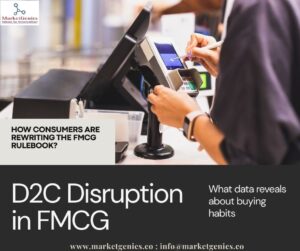The conventional management of the Fast-Moving Consumer Goods (FMCG) sector has been built upon a complex distribution ecosystem involving multiple layers of wholesalers, distributors, and retail stores. However, this model is being rapidly replaced—or at least complemented—by a more agile and consumer-centric approach: Direct-to-Consumer (D2C).
The shift isn’t just a result of technological advancements; it reflects an evolution in consumer preferences. Modern buyers value personalization, transparency, speed, and brand authenticity—things that D2C brands are designed to deliver. As the line between manufacturers and consumers blurs, FMCG companies are embracing digital channels to build deeper, data-driven relationships. Let’s see what MarketGenics research says on the sector.

The Direct-to-Consumer model enables brands to bypass traditional intermediaries and reach consumers through their own platforms—such as websites, mobile apps, and social media. By selling directly, brands gain complete control over their pricing, narrative, and customer experience.
This is particularly disruptive in the FMCG sector, where traditional players have long relied on brick-and-mortar dominance. Now, newer D2C-first brands are using technology and storytelling to carve out significant market share. From skincare to snacks and beverages, these companies are reshaping what it means to be a consumer goods brand in the digital age.
While the D2C model is promising, it comes with its own set of challenges:
The global D2C FMCG market is expanding at an unprecedented pace. According to MarketGenics,
Global FMCG Market: It’s anticipated that the total FMCG market will increase from USD 15,829.84 billion in 2022 to USD 22,863.25 billion by 2030, with a CAGR of 4.5% over the forecast period.
FMCG Packaging Market: The global FMCG packaging market’s revenue was USD 440 billion in 2022, and it’s projected to exceed USD 770 billion by 2030, with the market undergoing a CAGR of 5.9% during the forecast period.
Direct Selling Market: The direct selling market is predicted to expand to USD 328.26 billion by 2030, attaining a CAGR of 6.4% between 2023 and 2030.
This surge is not only being fueled by startups, but also by large FMCG corporations that are launching D2C wings or acquiring smaller players.
Millennials and Gen Z consumers, who grew up in the digital age, prefer buying directly from brands. MarketGenics reports say that over 70% of millennials trust and prefer D2C brand platforms over marketplaces. They associate direct shopping with better authenticity, faster delivery, and more personalized services.
Unlike traditional FMCG sales that cater to the mass market, D2C thrives on individualization. MarketGenics analysis tells that nearly 76% of consumers are more likely to purchase from brands that offer personalized experiences ranging from tailored product recommendations to customized packaging and offers.
MarketGenics analysis says that nearly 48% of global buyers actively seek brands aligned with their personal values whether it’s sustainability, cruelty-free testing, or clean ingredients. D2C platforms offer the space for brands to share detailed sourcing stories and community impact, creating deeper emotional loyalty.
The U.S. remains the world leader in D2C adoption. Brands such as Dollar Shave Club, Glossier, and Warby Parker have set new standards for direct engagement. In 2022, the U.S.
Global D2C Market: The global D2C market is expected to grow from USD 196.12 billion in 2023 to USD 571.34 billion by 2031, at a CAGR of 14.3% during the forecast period.
Global D2C E-commerce Market: The D2C e-commerce market size is projected to grow to USD 242.48 billion by 2034 at a CAGR of 11.42% during 2025-2034.
North America D2C Market: The North America D2C market in the U.S. is expected to observe notable growth over the 2021–2027 period, with e-commerce and digital expansion being the driving force.
U.S. consumers are drawn to the convenience, price transparency, and superior experience that D2C platforms provide.
India’s D2C boom is being driven by factors like high mobile penetration, increased digital literacy, and government initiatives such as Digital India and Startup India. India is home to over 900+ D2C brands, and the sector is projected to grow to USD 300 billion by 2030.
European consumers are highly conscious of sustainability and ethical sourcing, making it a fertile ground for purpose-driven D2C brands. Regulations such as the General Data Protection Regulation (GDPR) and the Digital Services Act have created safer, more transparent online environments, supporting the growth of small and medium-sized D2C players.
The Trump-era tariffs under Section 301 imposed additional duties on Chinese imports, impacting the cost structures of several FMCG brands, particularly those sourcing raw materials or packaging from Asia. D2C brands, which often operate on tight margins, were initially hit hard.
However, this disruption prompted many to localize production, diversify suppliers, and promote “Made in USA” or “Made in India” tags as a badge of quality and trust. In hindsight, while tariffs created short-term pain, they ultimately helped build more resilient and locally rooted supply chains, which customers appreciate and support.
The rise of D2C in FMCG isn’t a passing trend—it’s a powerful transformation driven by consumers’ demand for meaningful engagement, not just convenience. As digital infrastructure grows and customer expectations evolve, D2C will play a central role in shaping the future of the consumer goods industry.
By placing data, design, and dialogue at the heart of operations, D2C brands are building not just market share—but community and loyalty. Those that can balance innovation with empathy, tech with trust, and scale with service will define the next chapter of FMCG.


MarketGenics India is a MRSI certified company.
Send us your resume at
info@marketgenics.co
© 2025 MarketGenics India Pvt Ltd.; All rights reserved